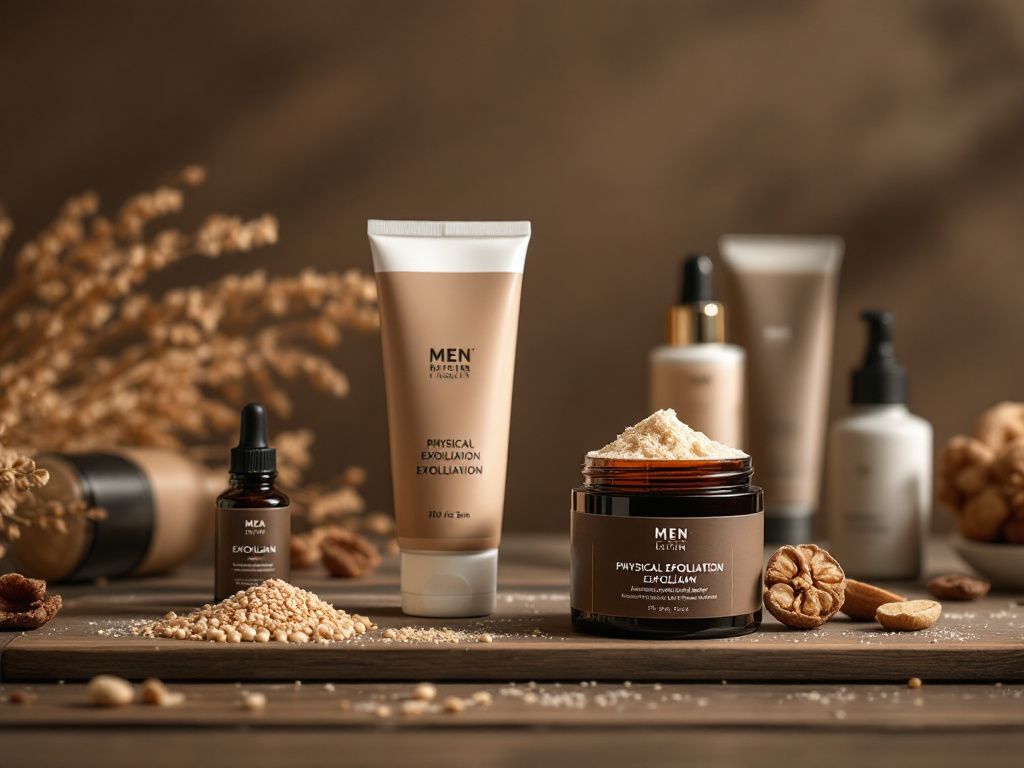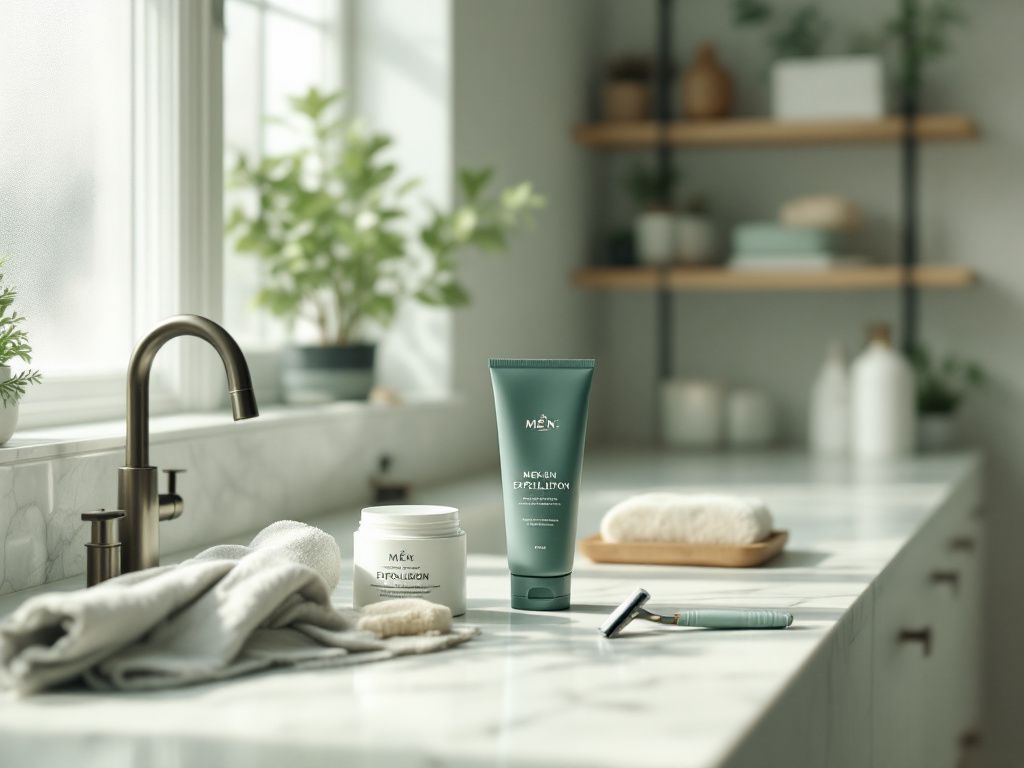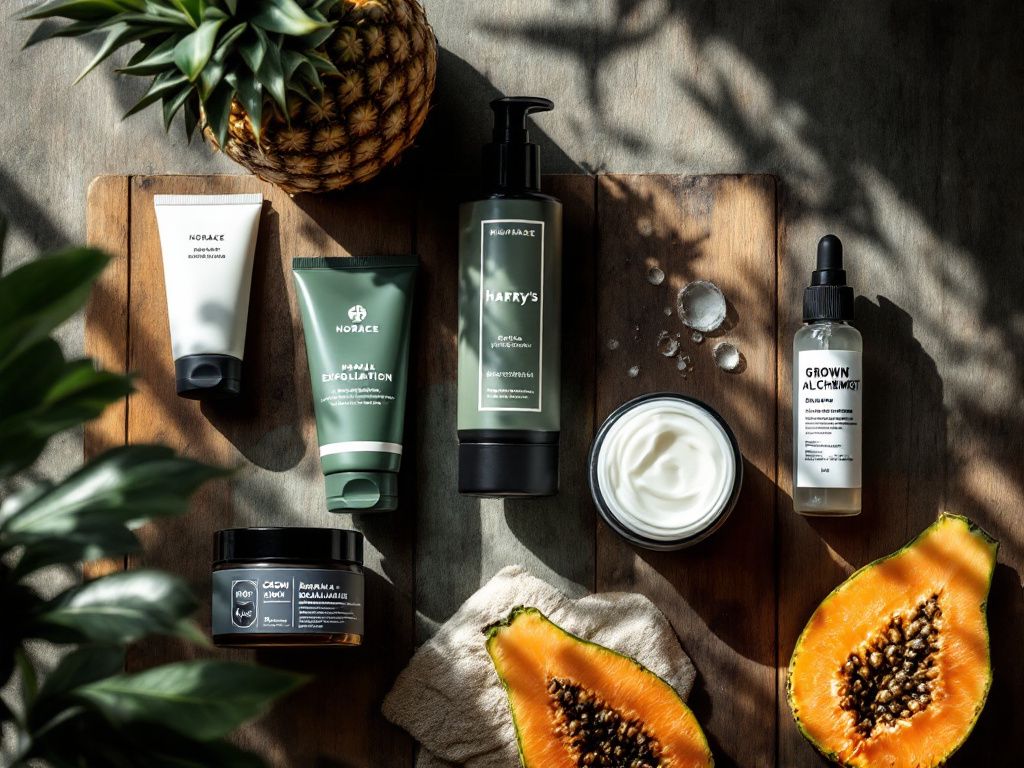Men’s skin presents unique characteristics requiring specialised care approaches. With 25% thicker epidermis, higher sebum production, and increased collagen density compared to women’s skin, effective exfoliation becomes essential for maintaining healthy skin texture, reducing ingrown hairs, and enhancing overall appearance. This comprehensive guide explores proper techniques and products for optimal results.
Good to know : Men’s skin is approximately 25% thicker than women’s skin and produces significantly more sebum, leading to enlarged pores and increased dead skin cell accumulation. This unique structure requires regular exfoliation 2-3 times weekly for normal skin types to maintain optimal texture and prevent ingrown hairs, particularly around facial hair areas where dead cells tend to build up more rapidly.
Understanding men’s skin and the importance of exfoliation
Men’s skin presents unique characteristics that fundamentally differ from women’s skin, making targeted exfoliation approaches essential for optimal skincare results. Understanding these distinctive features provides the foundation for developing an effective exfoliation routine that addresses masculine skin concerns whilst maximising the benefits of subsequent skincare products.
The distinctive anatomy of men’s skin
Men’s skin demonstrates several key physiological differences that directly impact exfoliation requirements. The epidermis measures approximately 25% thicker than women’s skin, creating a more robust barrier that requires more intensive exfoliation techniques to penetrate effectively. This increased thickness stems from higher testosterone levels, which stimulate greater collagen production and result in denser skin structure.
Sebaceous glands in men produce significantly more sebum, with studies indicating up to twice the oil production compared to women. This excessive sebum combines with dead skin cells to create stubborn blockages within pores, leading to enlarged pore appearance and increased susceptibility to blackheads and breakouts. The higher oil production necessitates regular exfoliation to prevent accumulation and maintain clear skin surface.
| Skin Characteristic | Men | Women | Impact on Exfoliation |
| Epidermal Thickness | 25% thicker | Standard | Requires stronger exfoliation |
| Sebum Production | 2x higher | Standard | More frequent exfoliation needed |
| Collagen Density | Higher | Lower | Better tolerance for physical exfoliation |
The science of skin cell turnover and exfoliation benefits
Natural skin cell turnover occurs approximately every 28 days in healthy adult skin, though this process slows with age. Dead cells accumulate on the skin surface, creating a dull appearance and preventing optimal absorption of skincare products. Facial hair further complicates this process, as whiskers trap dead cells and debris, creating an environment conducive to ingrown hairs and irritation.
Regular exfoliation accelerates the natural cell renewal process, revealing fresh, healthy cells beneath. This process delivers multiple benefits specifically relevant to men’s skincare needs:
- Enhanced shaving experience through removal of dead cells that can clog razors
- Reduced ingrown hairs by preventing follicle blockages
- Improved product absorption, maximising moisturiser and serum efficacy
- Smoother skin texture and reduced appearance of enlarged pores
- Prevention of acne and blackhead formation
Growing awareness in men’s skincare
Recent market research indicates that 73% of men now use skincare products beyond basic cleansing, with exfoliation products experiencing particularly strong growth. This shift reflects increasing understanding of skincare science and recognition that men’s skin requires specialised approaches rather than generic solutions designed primarily for women’s skin characteristics.

Types of exfoliation: physical versus chemical methods
Understanding the science behind exfoliation methods empowers men to make informed decisions about their skincare routine. The choice between physical and chemical approaches depends on individual skin characteristics, tolerance levels, and specific concerns that need addressing.
Physical Exfoliation: Mechanical Removal Methods
Physical exfoliators work through mechanical action, using granules or tools to manually remove dead skin cells from the surface. These scrub formulations contain abrasive particles that require gentle circular motions to be effective without causing damage.
Common Physical Exfoliating Ingredients
Modern physical exfoliators use carefully selected micro-particles designed for men’s thicker skin. Jojoba beads offer spherical, biodegradable granules that provide gentle yet effective exfoliation. Rice powder delivers fine particles suitable for sensitive areas, whilst bamboo micro-crystals offer slightly more aggressive action for stubborn dead skin accumulation.
However, certain ingredients require caution. Walnut shell particles, though natural, can create microscopic tears in the skin due to their irregular, jagged edges. Ground apricot kernels present similar risks, potentially leading to irritation and compromised skin barrier function.
Professional Exfoliating Tools
Facial brushes and konjac sponges provide controlled physical exfoliation. These tools allow men to adjust pressure and intensity, making them particularly suitable for those with varying skin sensitivity across different facial areas.
Chemical Exfoliation: Acid-Based Solutions
Chemical exfoliators dissolve the bonds between dead skin cells without requiring physical manipulation. This approach proves particularly beneficial for men prone to razor burn or those with sensitive skin conditions.
Alpha Hydroxy Acids (AHA) and Beta Hydroxy Acids (BHA)
| Acid Type | Concentration Range | Primary Benefits | Best For |
| Glycolic Acid (AHA) | 5-10% | Surface renewal, fine lines | Normal to dry skin |
| Lactic Acid (AHA) | 5-10% | Gentle exfoliation, hydration | Sensitive skin types |
| Salicylic Acid (BHA) | 0.5-2% | Pore penetration, oil control | Oily, acne-prone skin |
| Poly Hydroxy Acids (PHA) | 8-15% | Gentle renewal, moisture retention | Very sensitive skin |
Dermatological studies demonstrate that regular use of 2% salicylic acid reduces acne lesions by up to 60% over 12 weeks. Meanwhile, 10% glycolic acid treatments show significant improvement in skin texture and fine line appearance within 8 weeks of consistent application.
Choosing the Right Method
Men with oily, resilient skin typically benefit from physical exfoliating methods 2-3 times weekly, whilst those with sensitive or acne-prone skin should favour chemical exfoliator formulations. The cleanser base also matters – gel formulations suit oily skin, whilst cream-based products work better for dry or mature skin types.

Step-by-step guide to proper exfoliation technique
Mastering the proper exfoliation technique requires methodical preparation and precise execution to achieve optimal results whilst protecting your skin’s integrity. The following comprehensive approach ensures maximum benefits from your chosen exfoliation method.
Pre-Exfoliation Preparation
Before beginning any exfoliation routine, thorough skin assessment proves essential for determining the appropriate technique and intensity. Examine your face and body for active breakouts, cuts, or areas of heightened sensitivity that require special attention or complete avoidance during the process.
Begin with a gentle cleanser to remove surface impurities, makeup residue, and environmental pollutants. This initial cleansing step ensures your exfoliant can work effectively without interference from accumulated debris. Use lukewarm water to open pores slightly, facilitating deeper penetration of the exfoliating agents.
Skin Assessment Checklist
- Identify areas of sensitivity or irritation
- Note the presence of active acne or inflamed spots
- Check for recent cuts or abrasions
- Assess overall skin hydration levels
Facial Exfoliation Technique
Apply your chosen face scrub or chemical exfoliant using gentle, circular motions, working systematically across the entire facial surface. For physical scrubs, use minimal pressure – the granules should do the work, not your fingers. Limit application time to 1-3 minutes for physical exfoliants, whilst chemical formulations require adherence to specific product instructions, typically ranging from 5-15 minutes.
Focus particular attention on areas prone to congestion, such as the T-zone, whilst carefully avoiding the delicate eye area and any active breakouts. The skin around the eyes contains fewer sebaceous glands and requires gentler treatment to prevent damage.
| Facial Area | Technique | Duration |
| Forehead | Horizontal circular motions | 30-45 seconds |
| Cheeks | Upward circular motions | 30-45 seconds |
| Nose | Gentle vertical strokes | 15-30 seconds |
| Chin | Small circular motions | 15-30 seconds |
Body Exfoliation Methods
For larger body areas including shoulders, chest, and back, employ broader circular motions using either a body scrub or exfoliating mitt. These areas can tolerate slightly more pressure than facial skin due to their thicker dermal structure. Pay special attention to commonly neglected areas such as elbows and knees, where dead skin accumulation typically occurs.
When addressing the back area, consider using a long-handled exfoliating brush or seek assistance to ensure thorough coverage. Work systematically from top to bottom, allowing adequate time for the exfoliant to work effectively before rinsing.
Post-Exfoliation Care Protocol
Immediately following exfoliation, apply a gentle, fragrance-free moisturiser whilst the skin remains slightly damp to lock in hydration. This critical step helps restore the skin’s protective barrier and prevents excessive dryness or irritation.
“Post-exfoliation care proves just as crucial as the exfoliation process itself. Neglecting proper aftercare can lead to increased sensitivity and compromised skin barrier function,” according to dermatological guidelines.
Mandatory sun protection with SPF 30 or higher becomes essential for at least 48 hours post-exfoliation, as newly exposed skin cells demonstrate increased photosensitivity. Avoid harsh cleansers, retinoids, or other active ingredients for 24-48 hours to prevent over-stimulation of the freshly exfoliated skin.
Common Mistakes to Avoid
- Over-exfoliation leading to redness and increased sensitivity
- Using excessive pressure during application
- Neglecting post-treatment moisturisation
- Failing to use adequate sun protection
- Combining multiple active ingredients immediately after exfoliation
Frequency and timing: creating an optimal exfoliation schedule
Establishing the right exfoliation frequency is crucial for achieving optimal skin health without causing irritation or damage. Men’s skin requires a tailored approach based on individual skin characteristics, environmental factors, and lifestyle considerations.
Skin Type-Specific Exfoliation Schedules
Different skin types require distinct exfoliation frequencies to maintain optimal health and appearance. Understanding your skin type is the first step towards creating an effective routine.
| Skin Type | Weekly Frequency | Best Method | Key Considerations |
| Sensitive | 1 time per week | Gentle chemical exfoliation | Monitor for redness or irritation |
| Normal | 2-3 times per week | Physical or chemical | Adjust based on skin response |
| Oily/Acne-prone | 3-4 times per week | Salicylic acid focus | Avoid over-drying |
| Mature | 2-3 times per week | Chemical exfoliation preferred | Focus on anti-ageing benefits |
Age-Related Frequency Adjustments
Dermatologists recommend adjusting exfoliation frequency based on age groups. Men in their twenties can typically handle more frequent exfoliation, whilst those over forty should focus on gentler, less frequent treatments to help maintain skin barrier function.
Seasonal and Environmental Considerations
Environmental factors significantly impact how often you should exfoliate your face and skin throughout the year. Summer months typically require increased frequency due to higher sebum production and increased exposure to pollutants.
- Summer: Increase frequency by 1-2 sessions per week due to elevated oil production
- Winter: Reduce frequency to prevent over-drying in harsh conditions
- High pollution areas: Consider an additional weekly session to help remove environmental toxins
- Air-conditioned environments: May require adjusted frequency due to altered skin hydration
Optimal Timing and Integration
The best time for exfoliation is during evening routines, as this allows the skin to recover overnight and reduces sun sensitivity risks. Morning exfoliation should be avoided, particularly with chemical exfoliants, as it can increase photosensitivity.
Weekly Schedule Integration
Creating a structured weekly routine helps maintain consistency whilst allowing skin recovery periods. Monday, Wednesday, and Friday evening sessions work well for most men, providing adequate recovery time between treatments.
Lifestyle Factor Adjustments
Personal lifestyle factors require schedule modifications to help optimise results. Stress levels, hormonal fluctuations, and travel can all impact skin sensitivity and exfoliation needs.
- High-stress periods: Reduce frequency by one session per week
- Hormonal changes: Monitor skin response and adjust accordingly
- Travel: Maintain routine but consider gentler formulations
- Seasonal allergies: Temporarily reduce frequency to prevent additional irritation

Choosing the right products: ingredients and formulations for men
Selecting the right exfoliation products requires understanding both your skin’s specific needs and the science behind effective formulations. Men’s skin, being approximately 25% thicker than women’s with higher sebum production, demands targeted ingredients and concentrations that can penetrate effectively whilst remaining gentle enough for regular use.
Key Active Ingredients for Men’s Exfoliation
The foundation of any effective exfoliator lies in its active ingredients. Salicylic acid stands as the gold standard for men with oily or acne-prone skin, working as a beta-hydroxy acid that penetrates deep into pores to dissolve excess oil and dead skin cells. Look for concentrations between 0.5-2%, with beginners starting at the lower end to build tolerance.
For anti-ageing benefits, glycolic acid proves most effective among alpha-hydroxy acids. This small-molecule acid penetrates deeply to stimulate cell turnover and collagen production. At-home formulations should contain 5-10% glycolic acid, whilst professional treatments may use concentrations up to 30%. Men with sensitive skin should consider lactic acid instead, which provides similar benefits with reduced irritation potential.
| Ingredient | Concentration | Best For | pH Level |
| Salicylic Acid | 0.5-2% | Oily/Acne-prone | 3.5-4.0 |
| Glycolic Acid | 5-10% | Anti-ageing | 3.5-4.0 |
| Lactic Acid | 5-12% | Sensitive Skin | 3.5-4.0 |
| Natural Enzymes | 1-5% | Gentle Daily Use | 5.5-6.5 |
Product Formulations and Applications
Different formulations serve distinct purposes in men’s skincare routines. Cleansers with exfoliating properties offer daily gentle renewal, whilst concentrated serums provide intensive treatment for specific concerns. Physical scrubs work best for men with thicker, less sensitive skin, particularly those with facial hair that can benefit from the mechanical action.
- Gel formulations: Ideal for oily skin types, providing deep cleansing without over-drying
- Cream-based scrubs: Perfect for normal to dry skin, offering hydration alongside exfoliation
- Liquid exfoliants: Best for beginners or sensitive skin, allowing precise application control
- Mask formulations: Suitable for weekly intensive treatments, often combining multiple acids
Budget Considerations and Brand Recommendations
Quality exfoliation products span various price ranges, with effective options available across all budgets. Budget-friendly options (£5-15) include brands like CeraVe and The Ordinary, offering clinically-proven ingredients at accessible prices. Mid-range products (£15-40) from brands like Horace and Harry’s provide men-specific formulations with enhanced textures and packaging. Premium options (£40-80+) from Grown Alchemist and SK-II offer luxury experiences with advanced ingredient combinations.
When selecting products, prioritise those with proper pH levels (3.5-4.0 for chemical exfoliants) and look for certifications such as dermatologist-tested or non-comedogenic labels to ensure safety and efficacy for your skin type.

Advanced techniques and professional treatments
Beyond traditional at-home exfoliation methods, men seeking enhanced skin results can explore advanced techniques and professional treatments that deliver superior outcomes. These sophisticated approaches offer deeper exfoliation and more dramatic improvements in skin texture, tone, and overall appearance.
Professional Exfoliation Treatments
Professional treatments provide controlled, intensive exfoliation that surpasses home care capabilities. Microdermabrasion stands as one of the most popular professional options, utilising either crystal or diamond-tip technology to remove the outermost layer of dead skin cells. This mechanical exfoliation method helps reduce fine lines, improve skin texture, and enhance product absorption.
Chemical peels offer another powerful professional approach, with varying intensities to suit different skin concerns. Superficial peels using 20-30% glycolic acid provide gentle renewal suitable for regular maintenance, while medium-depth peels employing 35-50% trichloroacetic acid (TCA) address more significant concerns like deeper wrinkles and sun damage.
| Treatment Type | Cost Per Session | Recommended Frequency | Recovery Time |
| Microdermabrasion | £80-150 | Every 2-4 weeks | None to minimal |
| Chemical Peels (Superficial) | £100-200 | Every 4-6 weeks | 2-3 days |
| Chemical Peels (Medium) | £200-300 | Every 3-6 months | 7-10 days |
| HydraFacial | £120-180 | Monthly | None |
Emerging Technologies
HydraFacial treatments represent cutting-edge technology, combining cleansing, exfoliation, extraction, and hydration in a single session. This multi-step process uses patented vortex suction to remove impurities while simultaneously infusing beneficial serums.
Advanced At-Home Techniques
Sophisticated tools can enhance home exfoliation routines significantly. Konjac sponges provide gentle daily exfoliation suitable for sensitive skin, while silicone cleansing brushes offer controlled mechanical action. Exfoliating mitts deliver more intensive physical exfoliation, particularly effective for body treatments.
- Sonic cleansing devices for enhanced product penetration
- Enzyme masks for weekly intensive treatment
- Retinol-based products for ongoing cellular renewal
- Professional-grade acid concentrations for experienced users
Safety Considerations and Contraindications
Professional treatments require careful consideration of individual skin conditions. Contraindications include active infections, recent sun exposure, certain medications, and compromised skin barriers. Men with darker skin tones face increased risks of post-inflammatory hyperpigmentation and require specialised protocols.
Clinical studies demonstrate that professional treatments achieve 40-60% greater improvement in skin texture compared to at-home methods alone, though combination approaches yield optimal long-term results.
Treatment packages typically range from £500-1500 for comprehensive series, offering better value than individual sessions while ensuring consistent progress toward skin goals.